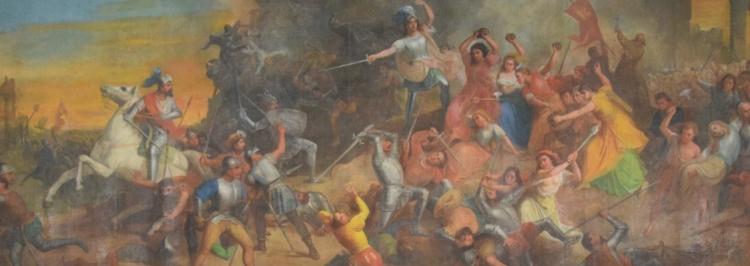Questo articolo è disponibile anche in:
![]() Italiano
Italiano
Restored velarium at at the Cagnoni Theatre in Vigevano: a rare case of a velario preserved in its original location.
It is a work by the painter Giovan Battista Garberini entitled The Siege of Vigevano.
The restoration was financed thanks to a fundraiser organised by the Associazione Amici del Teatro Cagnoni and the Fondazione Piacenza Vigevano.
Sipario alla ribalta, written by Edoardo Maffeo, Dino Rabai, Giovanni Borroni and Pier Luigi Muggiati and published by Ievve, is dedicated to this work.

Sipario alla ribalta was published with the contribution of ASM Energia, Amici di Palazzo Crespi, Soroptimist Lomellina and the patronage of the Municipality of Vigevano.
On Saturday 9 March at the Teatro Cagnoni foyer, the authors held the book presentation as speakers.

Edoardo Maffeo edited the part of the book concerning a careful biography of the Vigevano painter Giovan Battista Garberini.
Dino Rabai recounted what Vigevano was like at the end of the 19th century through meticulous research based on historical archives, interweaving his talk with curious and interesting information and anecdotes.
Giovanni Borroni dealt with the historiography of the 19th century on a national and international level as a century of important changes.
His speech offered a series of reflections that I really recommend not to miss: he himself called it a short chronology of a long century actually a long chronology of a short century.
I also leave you with the question that Giovanni Borroni asked those present: what is the historiographical sense of dividing history into centuries?
Pier Luigi Muggiati reassembled the historical facts, providing a precise reconstruction beyond the legend that has been handed down over time and revealing a particularly relevant detail.
But let us take a step back and return to the Siege of Vigevano portrayed on the velarium: if you pause to look at the scene depicted, you will notice that women are portrayed in the centre.

They are the ones strenuously defending the breach from the invaders commanded by Francesco Sforza, led by the woman depicted as a heroine in shining armour with drawn sword.
We have always known this character as Camilla Rodolfi.
However, Camilla Rodolfi is not a real woman: the name Camilla was inspired by the character in the Aeneid, while the surname Rodolfi belonged to an important family from Vigevano.
A woman who undoubtedly deserves mention is Pinin Brambilla Barcilon famous for the restoration of the Cenacolo: she was also the restorer of the Garberini’s velari, the book includes her report kept at La Venaria Reale.
Giovan Battista Garberini also painted a second curtain entitled La Festa sul Ticino.
Did you know that the curtain or velarium is also called a ‘comodino’ that more or less means handy?



 Hi I'm Claudia and this is KCDC.
Hi I'm Claudia and this is KCDC.




